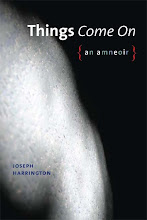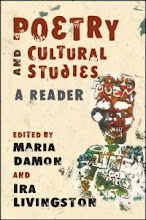There are, of course, BEAUTIFUL print journals. Volt, for instance. It is so tactilly and visually appealing that I find myself rubbing it against my chest somtimes (or I could, anyways). Ditto for P-Queue and a lot of others. Covers, too - the one on the last Tinfish, or several Forklift, Ohio's. If you wish to appeal to touch, print is the only and obvious way to go - with smooth-finished covers or letterpress covers that bear the impress of the type. This is the idea behind Slow Poetry. Anything 3-D is still best in print. Or, if you are appealing to a retro-techno abject aesthetic - whether mimeo, or stapled and spraypainted (a la With + Stand) or just photocopied and stapled, like Abraham Lincoln (the journal - the president died of a gunshot wound, I'm pretty sure), then dead trees and ink-dust are the way to go.
The best of the smallest print journals sell out. That's a minus, from the reader/librarian point of view, since if you didn't get one, you're SOL.
And there are a lot of crappy-looking on-line journals. And there are a lot of boring and mediocre-looking print ones.
Print: who is going to keep up with subscriptions? How soon will they cash the checks? (that's my pet peeve) Are you going to sell ads? Who's going to do the selling? Who will do the grant-writing and fundraising to capitalize the venture (i.e., pay for all the paper and printing)? Will you allow libraries to invoice you? Even if you do, how will you get them interested?
If I were running an on-line journal, I'd send e-mails to the periodicals librarian at all the universities and colleges where I wanted my journal to be read, pointing them to the URL and asking them to put it in their on-line catalog ("freely available via the internet," is the U of KS libraries' tag line). Then I'd follow up with a postcard in a few months, if it wasn't in the catalog already. Remember: libraries are cancelling print journals and increasingly relying on digtial substitutes.
AND (at ours, anyway) it's a heck of a lot easier to get them to order a multi-thousand dollar database than a $15 little mag subscription - b/c the former will invoice and fill out a W-9, etc.
Postage. I'm a huge fan of the Postal Service (UPS sucks, IMO), but it still costs more money than an internet "hit."
You can't link directly to pieces of paper.
You can't do audio, video, animation, podcasts, RSS feeds on paper - and it's more expensive to do still images.
Which is worse for the environment: a grove of felled trees, or a bucket of burnt coal? (I honestly don't know the answer)
from Startles
-
Startles
Upside down tee shirts hang on the line under an overhang, dripping from
the head space below. Half moon on white shirt or window whose tra...
3 days ago











6 comments:
Even so...I don't need electricity necessarily, or batteries that run out, to read a paper journal or book. I can't fall asleep with my laptop next to my pillow. Further, I seem to be (so far) incapable of extended literary reading on a monitor of any sort. My brain regards monitors as purveyors of instant and temporary information, not to be lingered over or upon. Blogs? OK. Essays? Maybe. A novel? Never!
KAMAU BRATHWAITE, JOSEPH HARRINGTON, ED ROBERSON, EVIE SHOCKLEY, & ELIZABETH WILLIS. Wesleyan University Press poetry reading, AWP Convention, Washington, D.C., early Feb. Date, time TBA.
Holy shiteen, I like that list!
Intimidated?? Who, me??
Kris - even if the reading machine were the same dimensions and weight of your average book? They aren't now, but I figure they will be. Still will have to plug it in some time.
Joe, we have a valulable source here in Lawrence in Ms. Lee Chapman who, during the past decade, published one of the best print journals in US..First Intensity. And then stopped. For all the reasons obvious and not. Just saying.
Good point, Jim. I'll try to get them to talk with her.
Post a Comment